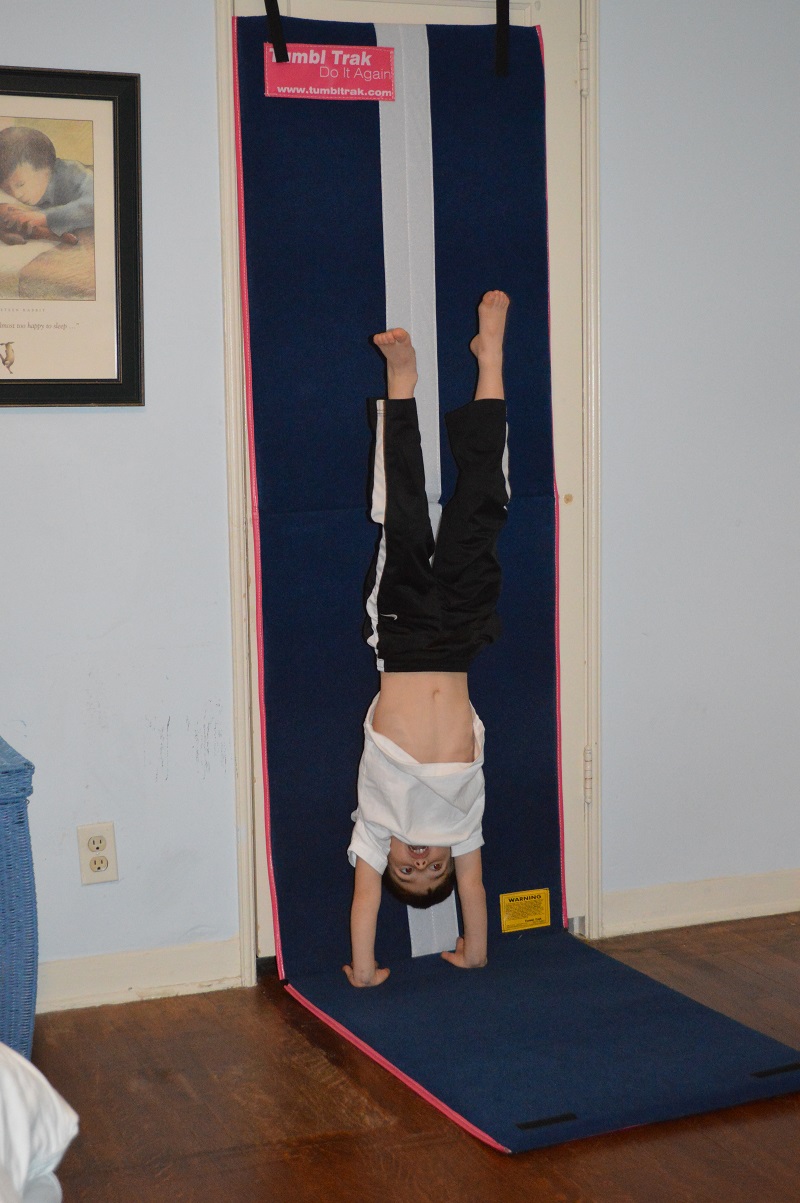Tumble the Night (or Day) Away for Fun and Fitness
 Every year when daylight savings time begins and cold weather arrives, kids are stuck indoors afterschool. When homebound kids start to get stir crazy, let them bounce off the walls, and roll with it, with some safe and energy-burning indoor tumbling.
Every year when daylight savings time begins and cold weather arrives, kids are stuck indoors afterschool. When homebound kids start to get stir crazy, let them bounce off the walls, and roll with it, with some safe and energy-burning indoor tumbling.
“Tumbling is a great way for kids to burn off energy and learn new skills,” says Carrie Spender, Education Outreach Program Coordinator for Tumbl Trak, makers of a variety of mats for homes and institutions.
“Kids will bounce on the bed, the couch and sometimes ‘off the walls,’ so set up a place in your house where they can do this safely,” says Spender. “Clear away any unsafe obstacles like lamps and sharp furniture that can cause injury, and use proper matting.”
With a few ground rules and pointers, teaching kids basic tumbling skills can be safe and easy.
First, talk with your kids about key body safe zones. Gently warn kids of the risks of hurting their neck, head or back, and show them how to move safely while protecting these areas.
Basic moves to avoid injury include tucking the chin toward the chest to protect the neck when rolling, bending the knees slightly to absorb impact when landing feet first, and safe falling or rolling backward with the arms crossed across the chest or above the head, instead of reaching back to break a fall, which is a major cause of wrist, elbow and shoulder injuries. These safety moves are great for the playground too.
Once safety basics are down, begin with the fundamentals. Spender suggests playing a pre-tumble game, such as singing “head, shoulders knees and toes” to warm-up the muscles before activity, and also to teach anatomy awareness. Another warm-up and strengthener is a log roll, where kids lie with a straight body, arms over the head, palms together, and roll sideways.
When muscles are limber and ready, begin with the most common first tumbling move, a forward roll.
Forward Roll
The easiest way to begin a front roll is standing with feet apart. Next, bend and place hands on the floor keeping the seat high in the air. Have your child look toward the knees with the chin tucked to the chest. Then, lean forward, lowering the back of the neck toward the ground. Continue the roll onto the back and finally to the seat. Eventually finish the roll on the feet.
“Unless your kid is Olympics bound, perfection is not the goal,” says Spender. “Pointed toes and straight legs are important in competitive gymnastics, but they are not a necessary focus at home.”
Handstand
The next move is the handstand, the building block of more advanced gymnastics moves. A safe handstand begins with strong arms and core. Have kids start with a push up position to see if they can first support some of their body weight with their arms. Gradually have kids move feet to higher levels, putting more and more weight on the hands and arms. Walking feet up a wall, called “spider walk,” with the front of their body facing the wall, is a safe way to gain strength to work up to a handstand.
Handstand mats, which attach to the back of a door, can be used for practice, to protect both the kid and the door.
Cartwheel
Once a kid learns a handstand, a cartwheel is a natural progression. A helpful cartwheel starter is a “tick-tock.” Standing with feet apart and arms stretched outward, the child will lean sideways, reaching one hand toward the floor while lifting the opposite foot up off the floor. They touch the hand briefly to the floor, then return to standing position. Once they are ready to cartwheel, they start with hands above head, in a lunge position, and reach forward, placing hands flat on the floor, one hand more forward than the other while kicking the back leg up in the air. The back leg will swing up and forward, landing on the other side of the hands. Lift hands off the ground while the second foot lowers toward the floor.
Waterfall Backward Roll
Backward rolls may seem basic but they are difficult to learn and commonly taught too early. A replacement is a waterfall backward roll. To learn this skill, a child lies on a bed or couch on his or her back with head toward the edge, with a tumbling mat, or other cushion on the floor. The child reaches hands above the head toward the floor, and creeps the body backward until hands touch the mat on the floor. With hands positioned flat, and arms strong and straight, the child raises feet toward the ceiling, then over head to the floor until child is kneeling, squatting or standing.
While teaching this and all tumbling skills, parents should take their time and talk with kids about how they feel every step of the way. So that kids learn skills and build their strength, parents should avoid the temptation to grab a kid’s ankles and hold them up in a handstand, or, spotting them by holding them while they are learning. On a safe, padded surface, parents can help kids learn tumbling skills by letting them practice on their own to help them build a foundation of self-esteem in the sport.





